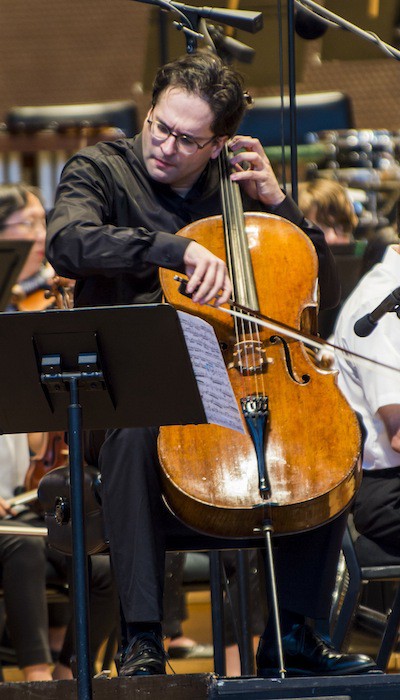Kalmar, Grant Park Orchestra deliver rare gold with two American symphonies

Carlos Kalmar led the Grant Park Orchestra in music of Harris, Piston and Shostakovich Wednesday night at the Pritzker Pavilion. File photo: Norman Timonera
Few American works capture the spirit of their times more economically than Roy Harris’s Symphony No. 3. Written in 1939, Harris’s Third, cast in a closely argued, single movement of 18 minutes, seems to encapsulate Depression-era America, with its dark string lines, stoic lyricism and lean, elegiac expression.
Premiered and first recorded by Serge Koussevitzky and the Boston Symphony Orchestra, the Harris Third Symphony was a repertory staple in American concert halls for much of the mid-20th century–Leonard Bernstein was a consistent champion–until falling out of favor in recent decades.
Harris’s Third was revived by Carlos Kalmar and the Grant Park Orchestra, along with a symphony by Walter Piston, another neglected homegrown composer of the 20th century, Wednesday night at the Pritzker Pavilion.
In Chicago’s current era of local urban carnage, deafening sirens and motorcycle noise have become the ceaseless ambient sounds of downtown, and Wednesday night was worse than usual. The screaming police and ambulance sirens as well as the leaning on horns more than once threatened to obliterate the musical performances completely. Kalmar and the Grant Park musicians deserve a grace under pressure award for maintaining their composure and playing with polish and commitment.
Kalmar showed a firm grasp of Harris’s challenging, elusive Third. The cello section launched the score with deep-pile richness and Kalmar maintained taut concentration and strong momentum, bringing great swagger to the timpani-led fugal theme, and a sense of grim inexorability to the final bars.
Walter Piston’s star has descended even more precipitously than that of Harris–to the extent that for many he is better known today as Leonard Bernstein’s teacher at Harvard than as a composer in his own right.
Yet Piston stands among the greatest American composers of the 20th century. He was a much more consistent symphonist than Harris and his Second Symphony, written four years after Harris’s Third, is one of the finest of his eight works in the genre.
Though Piston’s style is often described as Neoclassical, there is nothing formal or staid about his music. Indeed it often breaks out into syncopated dance-like snatches, as in the first movement of the Second Symphony, a legacy of Piston’s youth playing clarinet in dance bands and pit orchestras. There is also restless contrapuntal rigor and a rugged, often strikingly beautiful lyricism.
Kalmar waited extra minutes for the al fresco cacophony to abate somewhat before giving the downbeat. The festival’s principal conductor and players seemed even more in synch with Piston’s idiom than with that of Harris. The shifting rhythms of the opening movement were handled with fizzing energy and Kalmar ensured that the jazzy dance tune went with wonderfully jaunty panache.
The Adagio offers one of Piston’s most characteristic lyrical inspirations. Charlene Zimmerman’s elegant playing brought out the searching expression and tinge of melancholy in the long clarinet solo of the main theme, with Kalmar and colleagues likewise conveying the deep vein of feeling in this ruminative music.
There was no sense of anti-climax in the final movement, with the orchestra playing with powerful, driven intensity and rounding off this craggy music with an emphatic coda. It’s hard to account for why Piston’s attractive, exquisitely crafted music is not heard more often in American concert halls.
The concert concluded with a much better-known work–Shostakovich’s Cello Concerto No. 1 performed by Christian Poltera.
The Swiss cellist’s performance Wednesday night was not among the most blazingly virtuosic outings one will ever hear of this work. Poltera clearly possesses an admirable technique, yet the cellist sounded cautious in the most bravura moments, sacrificing some of the danger and explosive qualities of this edgy, haunted music.
Yet this was for the most part an impressive festival debut. The soloist brought dynamic, rhythmically pointed playing to the outer movements and was clearly in synch with the concerto’s interior, brooding qualities. The slow movement and extended cadenza were the highlights, with the sirens abruptly abating, and allowing Poltera to explore a wide range of subtle inward expression.
Kalmar and the orchestra provided alert and sympathetic support, not least Jonathan Boen in the prominent horn role.
Carlos Kalmar leads the Grant Park Orchestra in an all-Tchaikovsky program 6:30 p.m. Friday and 7:30 p.m. Saturday. The program includes Marche slave, the Suite No. 3 and the Piano Concerto No. 1 (1879 version) with Kirill Gerstein as soloist. gpmf.org
